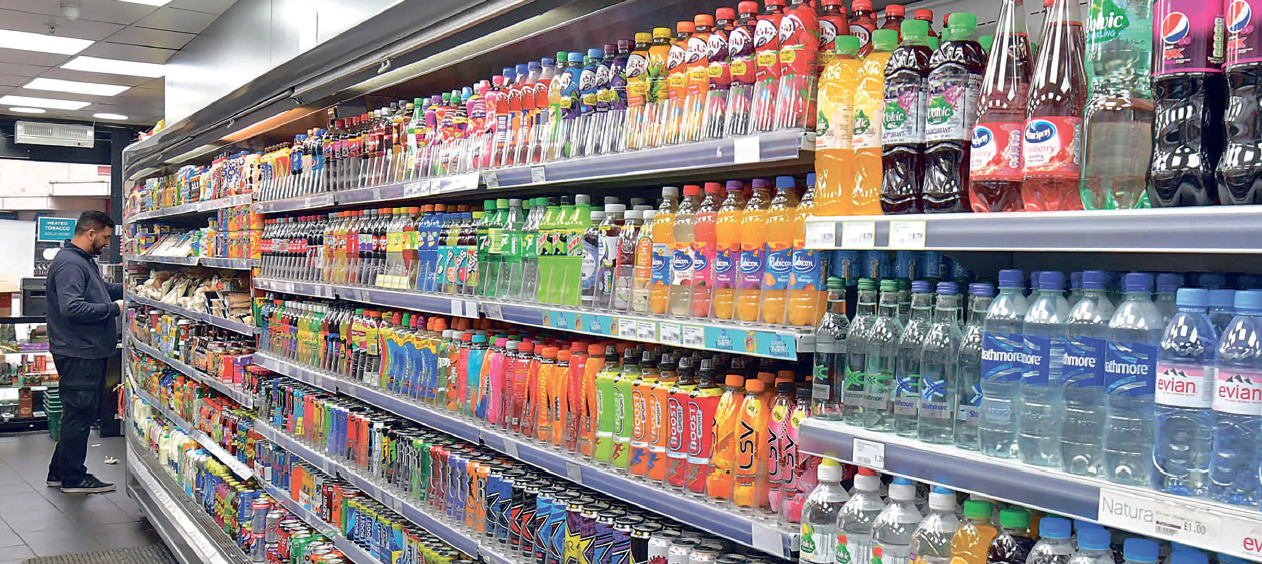What water drinkers want
Bottled water could be set for a big year after taking a hit due to the pandemic. With people confi ned to their homes, they often turned to their taps for their hydration, preferring to spend on soft drinks and alcohol. Now that restrictions have lifted, a renewed health focus has put water in retail under the spotlight.
“In soft drinks, low-sugar options continue to grow ahead of full-sugar varieties and drinks with added benefi ts, such as vitamins, are a growing trend,” says Clare Denham, customer category director at Danone UK and Ireland. “People are also consuming more water than ever before, with 17% growth in consumption year on year.
“Bottled water has recovered since the pandemic and is now the fastest-growing soft drinks segment. “From studies, we know drinking more water is the number-one way shoppers want to support their health, with 44% of people saying they are aiming to drink more water.”
For Vas Vekaria, of Kegs ’n’ Blades in Bolton, bottled water – including fl avoured varieties, with the exception of sparkling – accounts for just under half of his overall soft drinks sales. “We do 500ml, 750ml, 1l, 1.5l and 2l bottles, and I’ve got the full range of Volvic Touch of Fruit,” he says. “It’s good for kids who aren’t allowed fi zzy drinks at school, their parents pick them up for their lunchboxes because they’re sugar-free.”
Big brands
Certain brands lead the way in bottled water. Volvic and Evian are key brands for still water, with the former’s Touch of Fruit brand the number-one fl avoured water brand in the market.
“The [Volvic Touch of Fruit] Sugar Free range has grown in value sales by 36% over 2021, appealing to those who are watching their sugar intake,” says Gemma Morgan, category marketing director at Danone. Meanwhile, Coca-Cola Europacific Partner’s (CCEP) Glacéau Smartwater has experienced strong recent growth.
“Glacéau Smartwater is one of the top fi ve water brands, worth more than £25m,” says Amy Burgess, senior trade communications manager at CCEP. “It also became the fastest-growing top 10 bottled water brand over the 12 weeks to 1 January 2022, up 110.7% in value.”
However, stock shortages have seen retailers scramble for alternatives, and with water something the vast majority of shoppers can consume safely at home, some stores have found they aren’t too discerning. “I don’t do Evian anymore because it went out of stock ages ago and I’ve not got it back in since,” says Kesser Mahmood, of Da Shop in Stockport, Cheshire.
“I just gave the space to more Volvic and it sells really well.” Similarly, Vekaria turned to Ice Valley when he was unable to get Volvic. “I got Ice Valley bottles in at 99p for 2l which has basically killed big Volvic and Evian bottles in my store,” he says. “They all used to have two facings, now Evian and Volvic only have one. I don’t think people are bothered about the brand, they just want a bottle of water, especially when it’s a big one.”
Read more: Bottled Water Pricewatch
The relation of brands and sizes
Vekaria’s Ice Valley revelation points to a key aspect of water buying shoppers’ behaviour: the relation of size to value. As impulse-led sales make up the vast majority of bottled water sales, customers are willing to pay a slight premium for a 500ml or 750ml bottle of an established brand with plenty of advertising muscle behind it (think Evian’s annual Wimbledon blitz).
However, if you have the space, larger formats of cheaper brands and even ownlabel formats can also sell well. While the majority of his sales are chilled 500ml singles, Shakeel Arshad, of Spar Sauchie in Alloa, Clackmannanshire, sells 5l bottles of Spar’s Silverbook Falls water. “With health becoming a massive topic for people watching what they’re eating and trying to go sugarfree, we’ve had growth in the sector year on year for the past fi ve years.”
When weighing up a water range, retailers should look to strike a balance between big brands, which can drive healthy post-pandemic sales and the less wellknown but more valueheavy larger formats driving take-home spend.
Sustainability and recycling
Water is not immune to the sustainability bug spreading across food and drink categories. “Recent research showed 61% of consumers are making more environmentally friendly, sustainable or ethical purchases, with 89% likely to continue post-pandemic,” says CCEP’s Burgess. “Glacéau Smartwater bottles have been made from 100% recycled plastic (rPET) since 2019 (excluding caps and labels) and this messaging features heavily on-pack and in consumer marketing campaigns helping to drive sales for retailers.”
Meanwhile, Evian Sparkling (the brand’s fi rst carbonated water launch) launched in a 33cl aluminium can and a 100% rPET bottle, while Buxton fi nalised making its entire range 100% rPET last year. With net zero and Scotland’s upcoming Deposit Return Scheme both hot-button issues, highlighting products with these attributes more prominently can help attract more environmentally concerned shoppers.
Read more category management advice and features






Comments
This article doesn't have any comments yet, be the first!